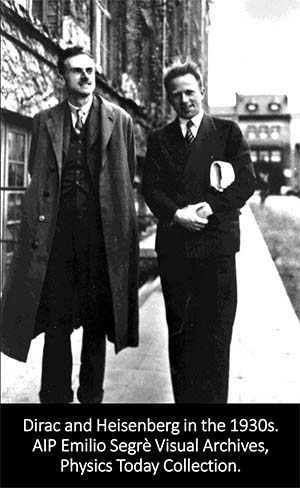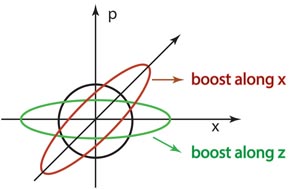Heisenberg's Gift to Einstein
Among the webpages I built on the history of physics, the page entitledis most frequently visited. Since this page is so popular, you are invited to visit this page again. For the same reason, I keep adding new stories about Heisenberg's meeting with Einstein.
- In 1954, Heisenberg went to Princeton to talk with Einstein, and
the meeting lasted longer than scheduled, according to Heisenberg.
However, it was not a successful meeting. After the meeting,
Einstein expressed his displeasure to his personal friend named "Johanna Fantova."
Click here for the story.
- Why did Heisenberg fail to make Einstein happy? The answer is
very simple. He was not able to tell a story Einstein wanted to hear.
Heisenberg was aware that Einstein did not like his interpretation
of the Poisson brackets. However, he could have made Einstein happy
by telling him the Poisson brackets lead to Einstein's relativity.
He could not tell this because he was not aware of this in 1954.

-
How did this young man become so close to Wigner? He told the stories Wigner
wanted to hear.
- In 1987, I surprised many people by publishing a paper with Eugene Wigner.
Wigner was known as one of the most difficult persons to approach, and
he was totally isolated from his colleagues at Princeton's physics department.
However, I was able to tell him the story he wanted to hear. The story goes like this.
- Einstein got his Nobel prize in 1921, but not for his mc2.
- Wigner got his prize in 1963, but not for
his 1939 paper on internal space-time
symmertries
- It is generally agreed that Einstein deserved one full Nobel for his mc2.
Likewise, Wigner deserved one full prize for his 1939 paper, and I showed him
the following table.
This table is from one of my papers published in 1986.Contents of Einstein's E = mc2
Particle Massive/Slow between Massless/Fast Einstein Energy
MomentumE = p2/2m E =
[m2c4 + (cp)2]1/2E = cp Wigner Helicity
spin, GaugeS3
S1 S2Winner's
Little GroupsHelicity Gauge Trans. - Einstein got his Nobel prize in 1921, but not for his mc2.
- Let us go back to the Heisenberg issue. Heisenberg could have
made Einstein by telling his E = m
2 is a conseqeunce of the symmetries derivable from his uncertainty commutation relations. He did not know this in 1954, but he could have said this based on a paper I published in 2019, with Sibel Baskal and Marilyn Noz. -
Here comes the key question. Did you know the Poisson brackets
lead to the Lorentz group? Don't worry. I am not the first person
who observed this. It was Paul A. M. Dirac who used two harmonic
oscillators to derive the group of Lorentz transformations. Dirac
in fact derived two coupled Lorentz groups or O(3,2) group starting
from two oscillators.
Dirac published this result in 1963 in the Journal of Mathematical Physics. This paper is largely unknown to the present generation of physicists, in spite of the fact that it provides the mathematical base for many branches of physics, including squeezed states, entanglements, entropy, high-energy physics, Bogoliubov transformation in superconductivity, O(3,2) supersymmetry, and presumably many future theories..
-
Both Dirac and Heisenberg were interested in the Poisson brackets.
Einstein did not like Heisenberg's interpretation of those brackets.
On the other hand, Dirac was interested in extending those brackets to
Einstein's Lorentz-covariant world.
Dirac's 1963 paper contains the ten generators of the Sp(4) group isomorphic to the O(3,2) Lorentz group. He constructed them from two harmonic oscillators or two Poisson brackets. Click here for those generators.
-
You may click here to enlarge this figure.
You may also be interested in a paper where the O(3,2) symmetry is
expanded to the O(3,3) symmetry with 15 Dirac matrices.
Click here for the paper
published in J. Math. Phys. [36], 3940-3954 (1995).

- The symmetry of the Poisson bracket leads to the
the Lorentz group.
- Then, while you did not know, how do I know about this paper? In
the fall of 1962, spent many hours with Dirac. How did this happen?
Click here for a story. At
that time, I did not like what was going on the physics world.
Click here to see how much I disliked
the physics environment at that time. I had to be born again, like
Nicodemus after seeing Jesus (Bible story from the Gospel of John).
Dirac's 1963 paper is difficult to read, because it consists of a mathematical poem consisting of ten generators and thus sixty commutation relations. It is fun to provide interpretations to this poem using physical examples, and this has been my research line for many years.
- Then, what does this have to do with Heisenberg? If Dirac got the
Lorentz group from the commutation relations for harmonic oscillators,
there must be the basic element of Lorentzian symmetry in Heisenberg's
Poisson brackets. Indeed, this symmetry is well known, and it is called
the group of canonical transformations.
The Poisson bracket consists of two conjugate variable x and p.
This bracket is invariant under rotations in the phase space of those two
variables. It is also invariant when x increases while p decreases while
the product xp remains constant. This is a squeeze in phase space. These
operations are enough to construct the Lorentz group applicable to the two
space-like and one time-like directions.
This symmetry is not rich enough address the symmetries in the Minkowskian space of three space-like and one time-like dimensions. Dirac in 1963 was able to construct his richer symmetries using the symmetry of two Poisson brackets. Yes, Einstein could have shown his interest in this symmetry of the Poisson brackets.
- The rotation in the phase space of x and p leads to the rotation around
y axis in the three-dimensional space. The squeeze along the x~p
directions leads to the Lorentz boost along the z direction. The squeeze
along the 45-degree direction corresponds to the Lorentz boost along the
x direction as shown in this figure.
The following table shows how the generators of the canonical transformations lead to those of the Lorentz transformations in the Minkowskian space of (x, y, z, t).
Click here for detailed calculations. - You may also be interested in the webpage entitled
Dirac's poems and Feynman's drums.
- This page reflects my strong Christian background. You will not
be surprised to hear about my oriental background. Why is it possible
for me to have a Christian background?
Click here for a story. There are of course pages reflecting
my oriental background. Here is
one of them.

|
|
- In 2019, I published the following papers telling that Einstein's E = mc2
can be derived from the Heisenberg brackets.
- Einstein's E = mc2 derivable from Heisenberg's Uncertainty Relations,
with Sibel Baskal and Marilyn Noz,
Quantum Reports [1] (2), 236 - 251 (2019),
doi:10.3390/quantum1020021.
ArXiv. For pdf with sharper images, click here. - Role of Quantum Optics in Synthesizing Quantum Mechanics and Relativity,
Invited paper presented at the 26th International Conference on Quantum Optics and Quantum Information (Minsk, Belarus, May 2019).
ArXiv. For pdf with sharper images, click here. - Poincaré Symmetry from Heisenberg's Uncertainty Relations,
with S. Baskal and M. E. Noz,
Symmetry [11](3), 236 - 267 (2019),
doi:10.3390/sym11030409.
ArXiv.
- Einstein's E = mc2 derivable from Heisenberg's Uncertainty Relations,
- copyright@2018 by Y. S. Kim, unless otherwise specified.
- Click here for his
home page.
- Einstein magazine.
- Princeton page.
- His stories. He likes to tell you stories.

|

|
